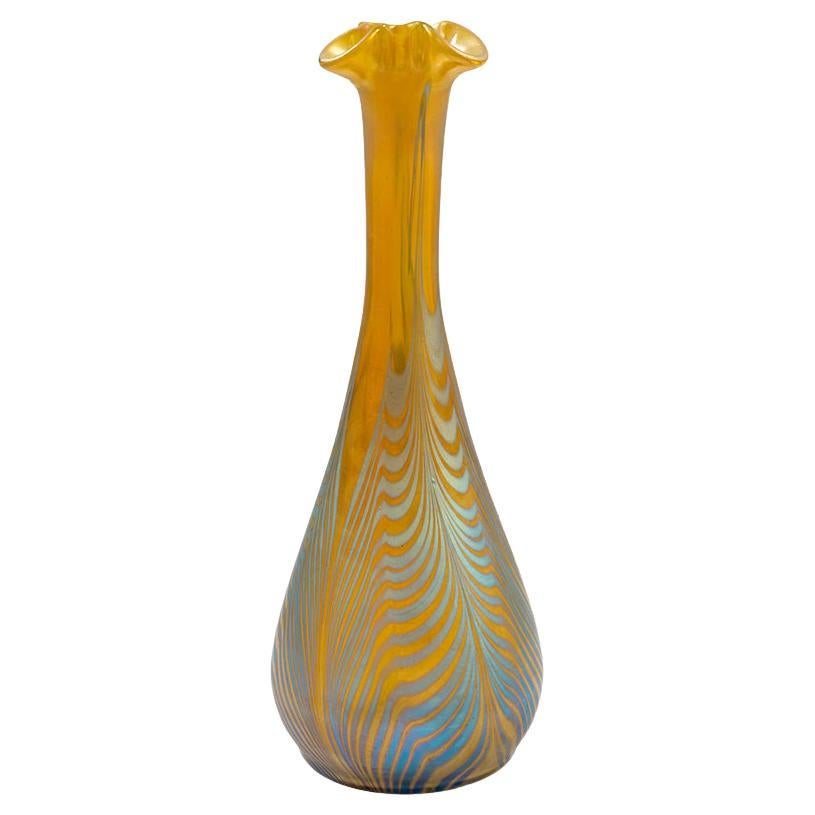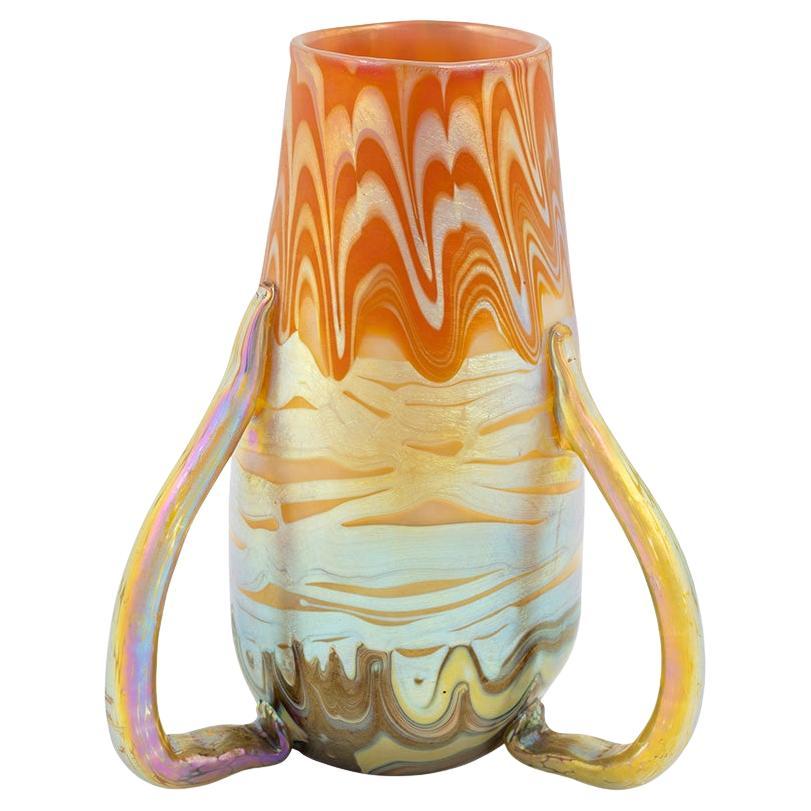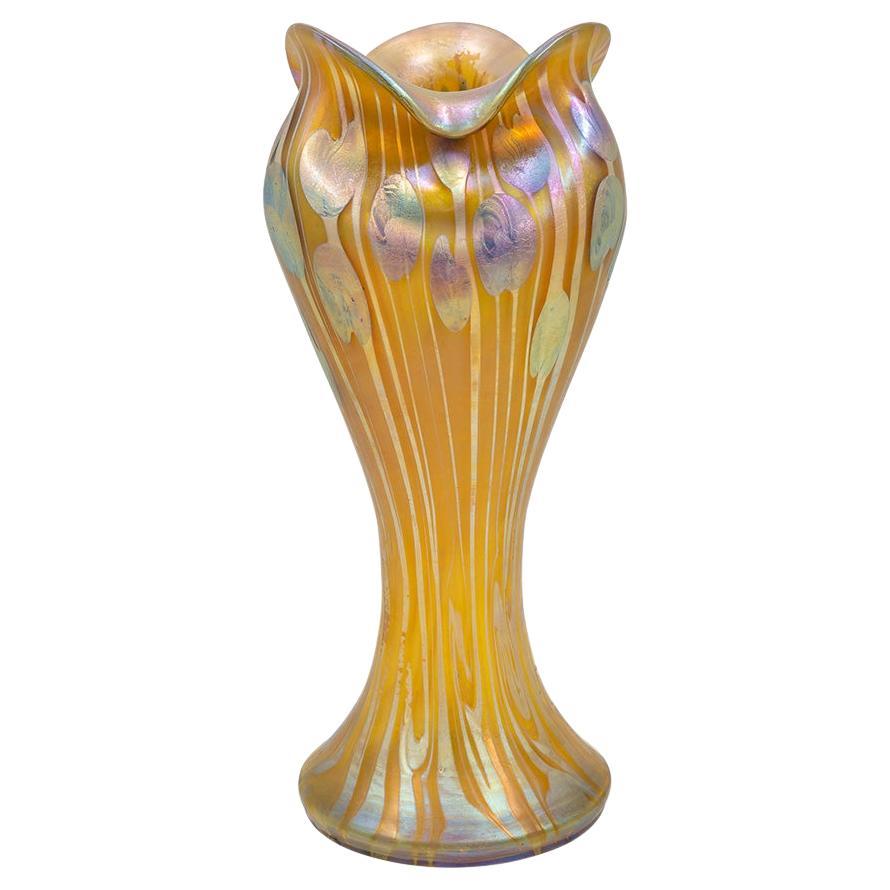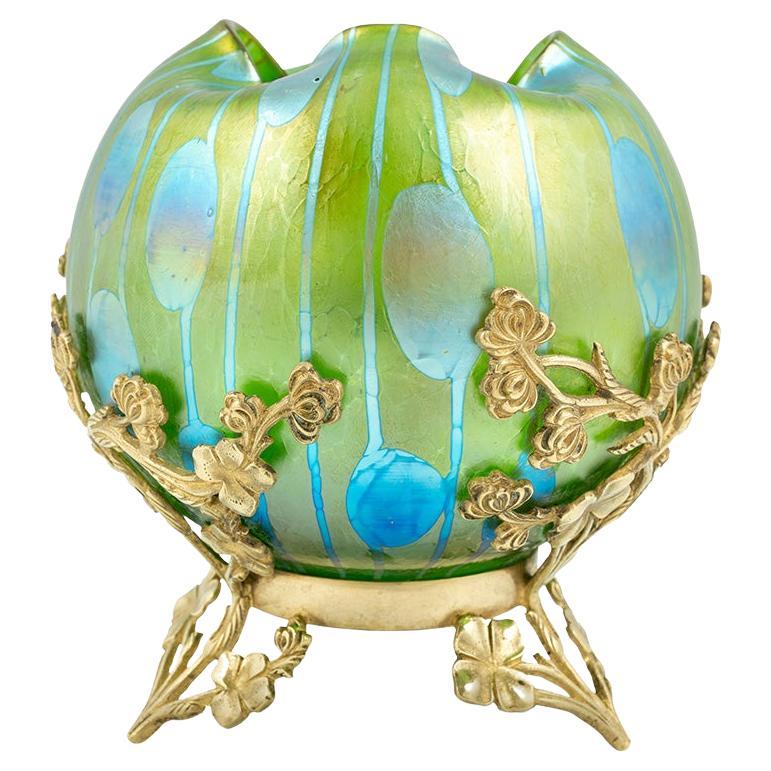Glass Vase Loetz Franz Hofstötter, circa 1901
About the Item
- Creator:Franz Hofstotter (Designer),Loetz Glass (Manufacturer)
- Dimensions:Height: 6.89 in (17.5 cm)Diameter: 3.75 in (9.5 cm)
- Style:Jugendstil (In the Style Of)
- Materials and Techniques:
- Place of Origin:
- Period:
- Date of Manufacture:1900-1902
- Condition:Wear consistent with age and use.
- Seller Location:Klosterneuburg, AT
- Reference Number:
Loetz Glass
Best known to collectors for their magnificent Marmoriertes and Phänomen glass creations, the Loetz Glass company was a leading Art Nouveau producer of fine glass vases, bowls and other decorative objects through the mid-19th and early 20th centuries.
Shortly before his death in 1855, attorney Frank Gerstner transferred sole ownership of his glassworks company to his wife Susanne. The company, which was founded in what is now the Czech Republic in 1836 by Johann Eisner, was renamed Johann Loetz Witwe by Susanne Gerstner as a tribute to her late husband who preceded Gerstner, a glassmaker named Johann Loetz (Loetz was also known as Johann Lötz).
For 20 years, Gerstner led the company, expanding its manufacturing and distribution capacity. It proved profitable, but the glassworks' popularity didn't start gaining significant momentum until after Gerstner transferred sole ownership to her grandson Maximilian von Spaun in 1879.
Von Spaun and designer Eduard Prochaska developed innovative techniques and solutions for reproducing historical styles of decorative glass objects, such as the very popular marbled Marmoriertes glass — a technique that lends glass an appearance that is similar to semi-precious stones such as onyx or malachite. Under von Spaun’s leadership, the firm’s works garnered them success in Brussels, Vienna and Munich, and Johann Loetz Witwe won awards at the Paris World Exposition in 1889. In 1897 von Spaun first saw Favrile glass in Bohemia and Vienna.
The work in Favrile glass, a type of iridescent art glass that had recently been developed and patented by Louis Comfort Tiffany, founder of iconic American multimedia decorative-arts manufactory Tiffany Studios, inspired von Spaun to explore the era’s burgeoning Art Nouveau style — or, as the firm was established in a German-speaking region, the Jugendstil style.
The company partnered with designers Hans Bolek, Franz Hofstötter and Marie Kirschner and thrived until von Spaun passed it down to his son, Maximilian Robert.
With the Art Deco style taking shape around the world, the company was unable or unwilling to adapt to change. Loetz Glass collaborated with influential names in architecture and design, including the likes of Josef Hoffmann, a central figure in the evolution of modern design and a founder of the Vienna Secession. Unfortunately, the glassworks’ partnerships did them little good, and the company’s mounting financial problems proved difficult to navigate. Two World Wars and several major fires at the glassworks took their toll on the firm, and in 1947 the Loetz Glass Company closed its doors for good.
Today the exquisite glass produced by Loetz Glass Company remains prized by collectors and enthusiasts alike.
On 1stDibs, find antique Loetz Glass Company glassware, decorative objects and lighting.
- ShippingRetrieving quote...Ships From: Klosterneuburg, Austria
- Return PolicyA return for this item may be initiated within 14 days of delivery.
- Josef Hoffmann Franz Hofstoetter Glass Vase Loetz, circa 1900By Franz Hofstotter, Josef Hoffmann, Loetz GlassLocated in Klosterneuburg, ATAustrian Jugendstil glass vase form by Josef Hoffmann for the VIII. exhibition of the Vienna Secession decoration by Franz Hofstoetter manufactured by Johann Loetz Witwe circa 1900 P...Category
Antique Early 1900s Austrian Jugendstil Glass
MaterialsGlass, Blown Glass
- Bohemian Glass Vase Loetz Austrian Jugendstil Yellow circa 1901By Loetz GlassLocated in Klosterneuburg, ATBohemian Glass Vase Loetz Austrian Jugendstil Yellow circa 1901 decoration PG 1/154 One of the main reasons for the big success of Loetz at the Pa...Category
Antique Early 1900s Austrian Jugendstil Vases
MaterialsArt Glass
- Glass Vase Loetz PG 358 Robert Holubetz Attributed, circa 1901By Loetz Glass, Robert HolubetzLocated in Klosterneuburg, ATAustrian Jugendstil glass vase manufactured by Johann Loetz Witwe design attributed to Robert Holubetz Phenomen Genre 358 decoration, circa 1901. This glass vase is an extraordinary ...Category
Early 20th Century Austrian Jugendstil Glass
MaterialsGlass
- Glass Vase Loetz with Drop Applications Blue Orange Iridescent, circa 1901By Loetz GlassLocated in Klosterneuburg, ATAustrian Jugendstil glass vase by Johann Loetz Witwe circa 1901 Phenomen Genre 1/78 decoration The vase pictured here, with its striking yet delicate form encased in remarkable "...Category
Early 20th Century Austrian Jugendstil Glass
MaterialsGlass
- Bohemian Glass Vase Loetz circa 1901 Viennese Art Nouveau Yellow Gold SilverBy Loetz GlassLocated in Klosterneuburg, ATVase, Johann Loetz Witwe, unidentified decoration, ca. 1901, signed "Loetz Austria" This elegantly curved vase with its luminous gold shimmering decoration gives it a fascinating appearance. The applied dots evoke images of water lilies, whose color spectrum ranges from silver-yellow to violet and blue depending on the incidence of light. The vertically drawn silver-blue threads emphasize the presence and size of the 31cm high body of the vase. The iridescent decoration is accentuated particularly by the organically curved basic form with its triple folded and expressively curved mouth. It allows us to experience the beauty of the vase's silver-yellow interior even from a distance. This exquisite work of art glass is destined for a true Art Nouveau heart...Category
Early 20th Century Austrian Jugendstil Glass
MaterialsGlass
- Glass Vase with Brass Fitting Koloman Moser Loetz circa 1901 Blue GreenBy Loetz GlassLocated in Klosterneuburg, ATGlass vase with brass fitting, Koloman Moser, manufactured by Johann Loetz Witwe, Streifen und Flecken decoration, ca. 1901, Art Nouveau, Jugendstil, Art Deco, art glass, iridescent ...Category
Early 20th Century Austrian Jugendstil Glass
MaterialsGlass
- Vase Loetz Widow Art Nouveau by Franz Hofstötter, circa 1900By Franz HofstotterLocated in Vienna, ATVase Loetz Widow Klostermuehle Bohemia Art Nouveau. Made by Loetz, Klostermu¨hle, circa 1900. Decor: Phaenomen Genre 358. Designed by: Franz Hofsto¨tter (1871-1958). Franz J. Hofsto¨tter was a German artist who worked at end of 19th century as well as in very early 20th century mainly on behalf of public communities. He created for example configurations and decorations for churches in Germany (church of Holy Heart in Ludwigsthal and church Saint Joseph in Weiden/Oberpfalz). After end of First World War Hofsto¨tter worked only for private clients. The artist had studied in Munich (painting, sculpture and architecture) / Hofsto¨tter worked on behalf of Lo¨tz Manufactory (Boehmia / Klostermu¨hle) in period as from 1896 until 1911, having designed most interesting glass items as well as female portraits made of glass: For this reason he received an accolade from jury of Paris World Exhibition 1900...Category
Antique Early 1900s Austrian Art Nouveau Glass
MaterialsGlass
- Antique American Art Nouveau Sterling Silver & Loetz Phaenomen Art Glass VaseBy Hartford Sterling Company, Loetz GlassLocated in Philadelphia, PAA fine Art Nouveau silver mounted art glass vase. Comprising a Loetz Phaenomen glass body in yellow with a silvery-blue iridescence and an Art Nouve...Category
Early 20th Century Jugendstil Vases
MaterialsSterling Silver
- Michael Powolny - Loetz - Bohemian Red Tango Glass Vase - C.R., Early 20th CBy Michael Powolny, Loetz GlassLocated in Chatham, ONAntique Bohemian Jugendstil red Tango glass vase - possibly designed by Michael Powolny (1871-1954) and manufactured by Loetz - rare form with ruffled rim ...Category
Early 20th Century Czech Jugendstil Glass
MaterialsGlass
- Loetz Art Nouveau Glass Vase Phenomenon Genre 7734, Austria-Hungary, circa 1898By Loetz GlassLocated in Vienna, ATMold-blown, baluster-shaped body on a flush stand, raised, widening, ribbed on the inside, forming a slight shoulder and short, straight neck, as well as stand area with ribs on the ...Category
Antique 1890s Austrian Art Nouveau Glass
MaterialsGlass
- Vase Loetz , Style : Art Nouveau , Bohemia, circa 1900By Loetz GlassLocated in Ciudad Autónoma Buenos Aires, CLoetz The glass factory, originally founded in 1836 by Johann Baptist Eisner, was taken over. Loetz was the premier Bohemian glass works during this period. It was located in Klostermühle, near Rejštejn in the Sušice district in South-West Bohemia, which belonged to the Austro-Hungarian Empire until 1918. Susanna Loetz, widow of Glass entrepreneur Johann Loetz in 1852. She renamed the company "Glasfabrik Johann Loetz Witwe", a name that was retained until all activities were stopped in 1947. In 1879 it passed to Max Ritter von Spaun. Under his guidance, together with director Eduard Prochaska, the glassworks flourished as never before and enjoyed its most successful period. Von Spaun and Prochaska concentrated on the development of innovative glass types and new production techniques. Their first successful speciality was a glass type simulating semiprecious stones. It is often called "Marmoriertes Glas" ("marbled glass"). The range contained Onyx (red/brown), Karneol (red/pink) and later Malachit (green). It was introduced in the second half of the 1880's. From the same period dates the Octopus glass, of which the decor resembles the tentacles of a cephalopod. The production of Marmorier-tes Glas was resumed in 1906, in different colours like yellow and white. Octopus, 1885-1890, 1885-1890, unknown, an Malachit, 1885-1890, unknown, The master glass-blowers of Klostermühle had already carried out experiments with iridescence in the first half of the 1890's, and they produced the Olympia, a classically inspired olive green type, in 1896. Similar, in variants of creta green, bronce or Olympia and averse to any redundant decoration was the Glatt decor. It highly contrasted with the more elaborate finishes of that time, but it constitutes a part of the production with a deep sense for taste and quality. Most of the pieces shown in the "Glatt" decors were manufactured for Max Emmanuel in London. The glatt decor remained in use for many years. The Chiné decor had thin glass threads spun around the body in irregular patterns. It is not to be confused with the type of glass that was produced by Kralik. Loetz "Chiné" came in clear, opal, green and pink, Kralik "Chiné" in dark purple. The logical sequel to Chiné was the Pampas decor, green or cobalt blue, in which the threads almost disappeared in the surface, with iridised parts in between. Around the same time the dotted Papillon decor was introduced. The beautiful silver spots were employed on a wide array of models and quite effective on the gooseneck (water sprinkler) and sea shell...Category
Antique Early 1900s Austrian Art Nouveau Glass
MaterialsArt Glass
- Green Bohemian Glass Vases in Style of LoetzBy Loetz GlassLocated in Topeka, KSLoetz like iridescent, green handblown glass vases. Although no certain proof has been discovered we strongly believe these to be Loetz. Selling as a pair only. In wonderful condition with no chips, cracks or chiggers. What an incredible pair of Bohemian green glass vases...Category
Early 20th Century Unknown Art Nouveau Glass
MaterialsGlass






